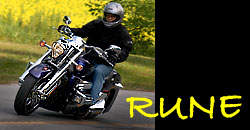
|
|
||||||||
VALKYRIE RUNE - A QUICKIE
 |
| I am a statement, therefore I am. |
Well, in Honda’s case it decided to build a cruiser that makes a statement. Remember the movie Conan the Barbarian? You know the scene where Arnold's horse-riding buddy clubs his foes over the head with a giant mallet? The Rune is that kind of statement.
At last week’s Canadian press launch* of the Rune, Warren detailed the origins of the beast.
*Humph, scooped by Mr. Richardson/Toronto Star—who got the bike for a whole day a few days prior. Kudos to Mark for carrying it off though. Bastard.
Grumble, grumble – Editor ‘arris
THE ROAD TO RUNE
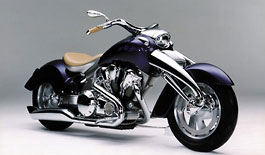 |
| The Zodia concept bike of 1995. |
The concept bike in question is the luscious Zodia v-twin, which made it’s premier at the Tokyo Motor Show in 1995. Utilizing trailing-link front suspension, rim mounted front disc, single-sided swing-arm and fluid drive, the Zodia got an overwhelmingly good public response …and got Honda’s gears turning. In 1996, when Honda introduced the Valkyrie—utilizing the stout flat-six GL1500 motor—the Honda brain thrust into second gear.
 |
| The Rune concept bikes. Left to right are the T1 to T4. Recognize the T2? |
Calling on some design elements of the Zodia and using a motor that is recognizably Honda—the horizontally opposed six of the Gold Wing/ Valkyrie—Honda’s US based designers developed four new concept bikes. Labeled the T1 through to T4, the Rune wannabe's hit the Long Beach, California bike show in December of 2000.
Of all the variations, the T2 received enough positive feedback that the green light was given for a limited production run, the challenge being that it had to be a near as possible reproduction to the concept T2. However, most concept bikes are just styling exercises to help gauge consumer reactions. Honda’s next task was to bring function to the style.
T-2-RUNE
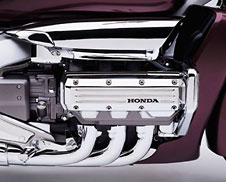 |
| GL1800 motor gets tuned-up. |
The motor was the easy part. Integrating the design with function required several innovative firsts for Honda:
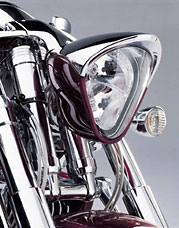 |
| Shocks are located behind the headlight. |
In the rear, Honda is happy to point out that the Unit Pro-Link suspension is modeled after the RC211V GP racer, with the upper shock mount contained in the swingarm and not the frame. This setup negates the need for a beefy frame cross-member to hold the upper shock mount. Beyond claims of superior function, it also allows the space for a very low seat height of 27.2” (690mm) while still providing 3.9” of wheel travel. It’s also mated to a single sided swing arm, which is also a Honda cruiser first.
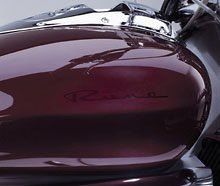 |
| Subtle. |
Aesthetics created their own demands. The 6.1-gallon tank was built with seamless construction—another first for Honda—while the wraparound rear fender utilizes flush mount LED brake lights. While being functional, they also don’t interfere with the fender’s round shape.
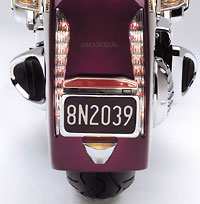 |
Several methods of firing order changes were tried, but the final solution came by crossing over two pipes under the engine between the two banks. It came at the expense of some horsepower but since they felt they had plenty anyhow it was worth it to get ‘the sound’.
 |
It took me a while to work this shot out - clutch master cylinder over gas tank. |
Other nice bits include very tasty hydraulic clutch and front brake reservoirs that are integrated with the rear-set bars. Overall build quality and componentry is top notch and very tasty for this made-in-Ohio special. Oh, and if you’re lucky enough to get one, you won't have the hassle of passengers as there are no passenger pegs!
RUN RUNE RUN
 |
| Mr. Boss tries to look professional while humming the Simpson's theme song and thinking of lunch. Note blank note pad. |
Seating position is comfortable thanks to the footpeg placement being in a standard position. This is due to the valve covers of the mighty six preventing the traditional cruiser placement up front. Although the reach to the bars seemed a bit too short for me (5’11” and shrinking) the overall ergos are comfortable. The seat is wide and not too deeply dished. The headlight is omnipresent in a good way.
 |
At idle, Honda has achieved a quiet version of a late 60’s small block Chevy. Once out of earshot of our hosts however, a nailing of the throttle replaces that rumble with the intake honk of something much sportier. Compared with the standard Valkyrie and VTX1800, the Rune is substantially quicker. The incredible linearity of the Valkyrie motor is still there, but a greater sense of urgency is present.
Despite a wheelbase that, to my knowledge, is the longest of any major bike manufacturers at 1750mm, the bike is eminently rideable. In fact in the tighter, slower and typically Ontario bumpy sections surrounding the launch site, the Rune felt more stable then the standard Valkyrie that I rode for comparison. Make no mistake, it’s still a heavyweight, but it felt lighter than the VTX1800 present, and numerous tight U-turns for photo opportunities were not a hardship.
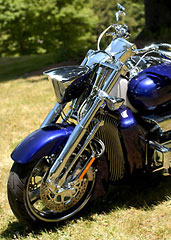 |
| Front suspension is a work of art. |
Besides being interesting, the suspension is very functional. It was the most comfortable by far in the group of test bikes available on launch day, including the VTX1300, VTX1800, Spirit 750 and a Valkyrie. Road imperfections are gobbled up and little is imparted on the rider.
The ride quality, seat comfort, decent ergos and a giant tank could see the Rune rack up some ample miles before a break is required.
RUNED FOR OTHER MOTORCYCLES?
 |
| Limited production ensures that you'll be unlikely to bump into another Rune rider. $35,000 ensures that it won't see rain either. |
While Honda wouldn’t provide actual figures on the quantity of units for sale in Canada, an educated guess would be in the 30-50 range. They will sell everyone of them, as it’s a stunning bike, perfectly functional and easy to ride.
As a showcase and flagship it achieves its goal. I’ll take two.
|
![]()
